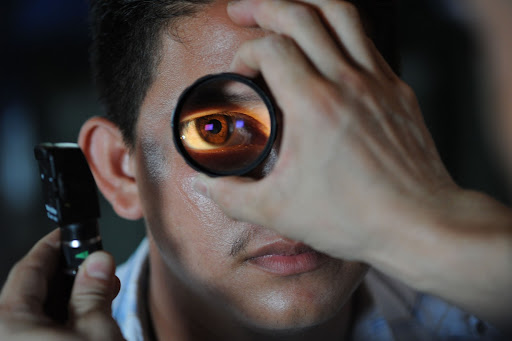What is the cause of a Macular Hole?
The interior of the eye is filled with vitreous fluid, a gel-like substance. The vitreous fluid contains fine fibres attached to the surface of the retina, which aid in the preservation of the eye's round shape. The vitreous fluid naturally shrinks and pulls away from the retina as we age. Natural fluids will then fill the spaces left by the vitreous fluid contraction. This is normal in people over the age of 50, and many have no adverse effects.
Some people will have harmless symptoms such as the presence of floaters, which are small specks that float in your field of vision. In some cases, the vitreous fluid is pulled away from the retina causing a macular hole to be formed. Natural fluids that fill the spaces left by the vitreous fluid seep through the hole and onto the macula, causing blurred and distorted vision.
Although age is the most common risk factor for developing a macular hole, macular holes can also occur in people who have had eye injuries or eye disorders such as macular pucker, myopia (near-sightedness), and retinal detachment.
What are the symptoms of a Macular Hole?
Patients with a macular hole may experience slight blurriness and distortion in their vision. Straight lines also appear bent or wavy and the combination of these symptoms causes difficulty in performing daily tasks.
What are the various stages of Macular Holes?
A macular hole has three stages:
-
Stage I (foveal detachment) - The fovea (a section of the retina) detaches.
-
Stage II (partial-thickness hole) - A partial thickness break causes a macular hole.
-
Stage III (full-thickness hole) – A full-thickness break occurs in the fovea.
The location and size of the hole determine how much of the patient's vision is affected. The most detailed and central vision is lost in stage III macular hole. If a macular hole is not treated, it can progress to retinal detachment, an eye condition that can result in permanent vision loss.
Diagnosis of a Macular Hole
Our ophthalmologists at EYECENTRIC Bukit Tinggi Medical Centre (BTMC) will first dilate your pupil with eye drops, allowing for a better examination of the inside of the eye using a special lens.
The retina will then be examined at a microscopic level using Optical Coherence Tomography (OCT). An OCT helps allows our ophthalmologists to photograph the retina to measure the size of the macular hole. EYECENTRIC ophthalmologists will be able to predict the stage of the macular hole as well as the outcome of the treatment that will be prescribed, in addition to the size.
What are the treatments for Macular Holes?
While some macular holes heal on their own, in most cases, a vitrectomy, which is a type of eye surgery, is required to seal the macular hole. A vitrectomy is the removal of vitreous fluid from the eye to prevent further damage of it pulling away from the retina. The area is then replaced by a bubble containing an air-gas mixture. The bubble serves as a temporary bandage, keeping the macular hole in place while it heals.
A patient who has a vitrectomy must remain in a face-down position for a period advised by the ophthalmologist. Because the patient is facing down, the bubble can push against the macula as it is gradually absorbed by the eye. Once the bubble is absorbed by the vitreous cavity, the space is naturally filled with natural eye fluids.
Early Detection Through Routine Eye Screenings
A macula hole can be detected early and prevented from worsening. Routine eye screenings are essential for maintaining your eye health. At Eyecentric Bukit Tinggi Medical Centre (BTMC), we encourage everyone, especially the elderly, to consult an ophthalmologist on a regular basis for routine eye screenings. Routine eye exams can assist your ophthalmologist in detecting and treating eye conditions before they worsen.
BTMC Eyecentric's experienced ophthalmologists and eye surgeons have years of training and practice in the field of ophthalmology, diagnosing and treating a wide range of eye conditions. Our patients are treated holistically, from diagnosis to prevention.





